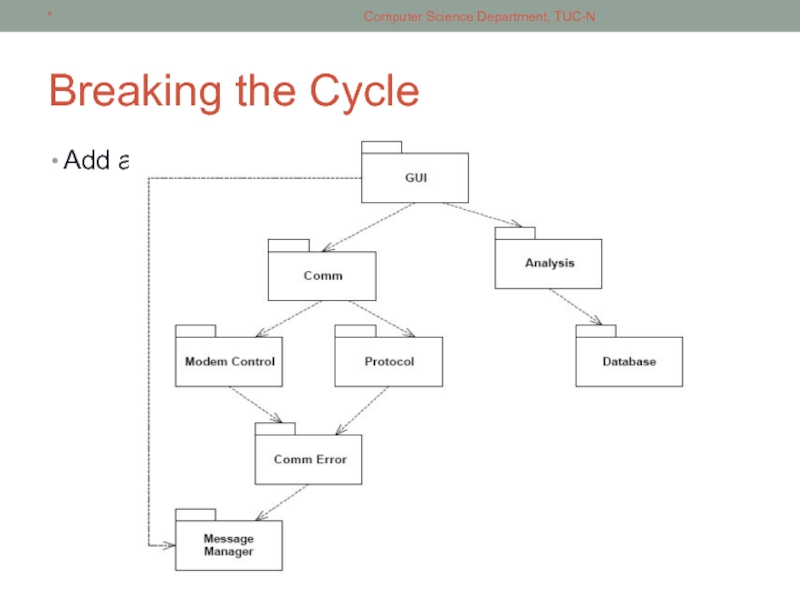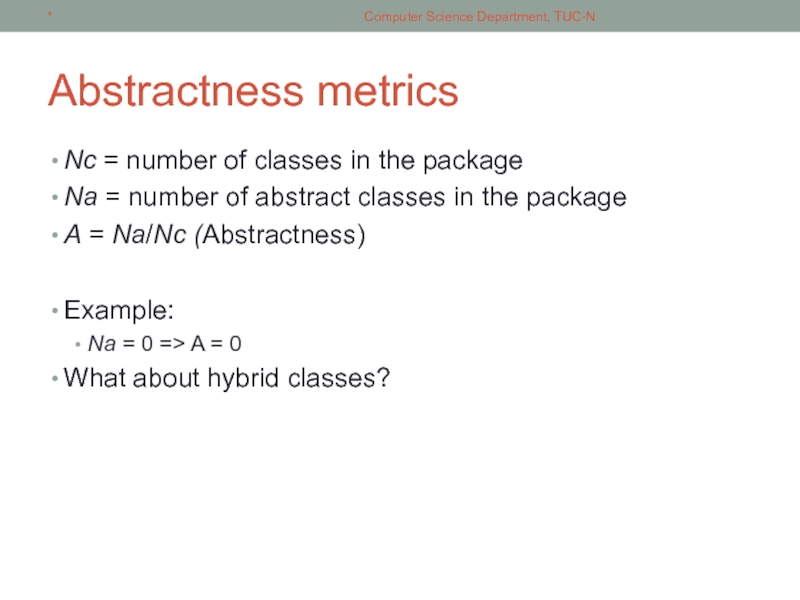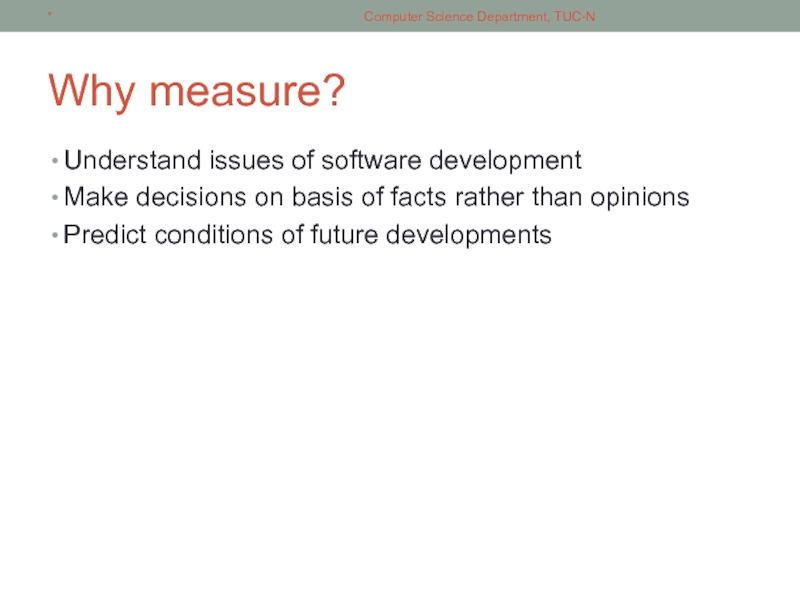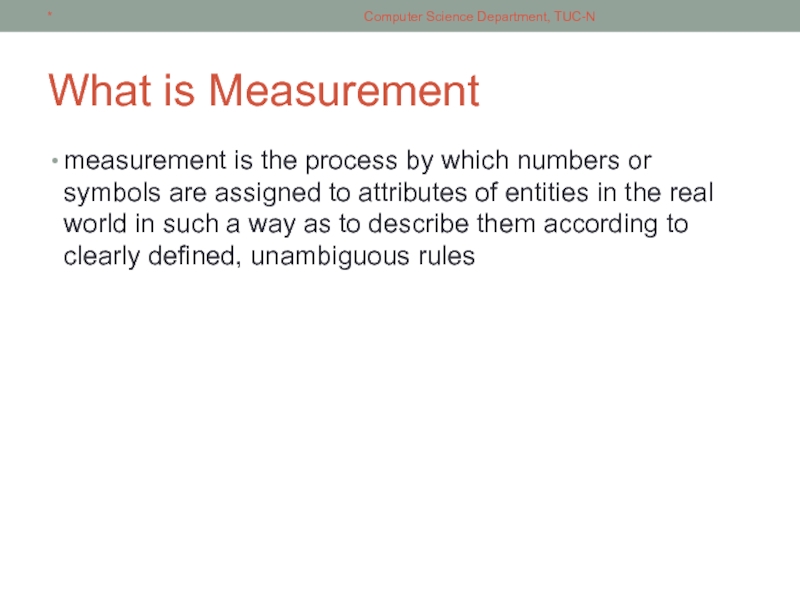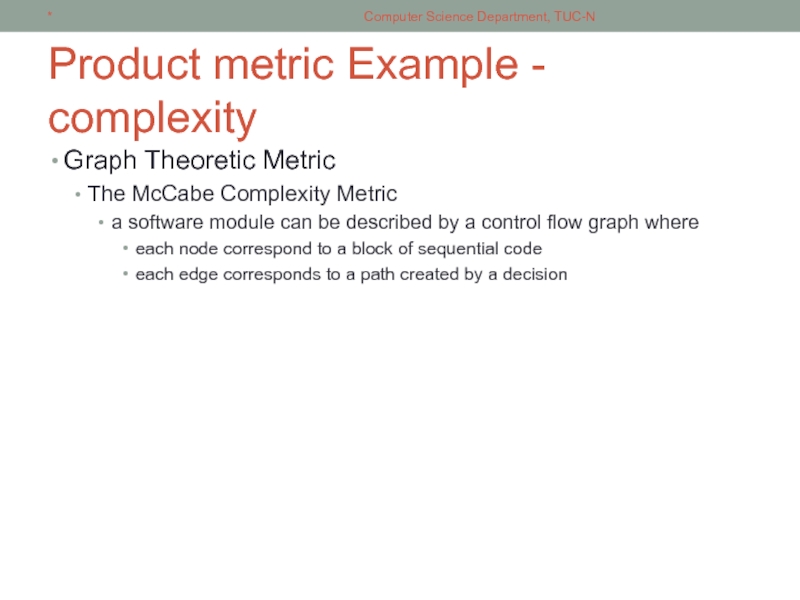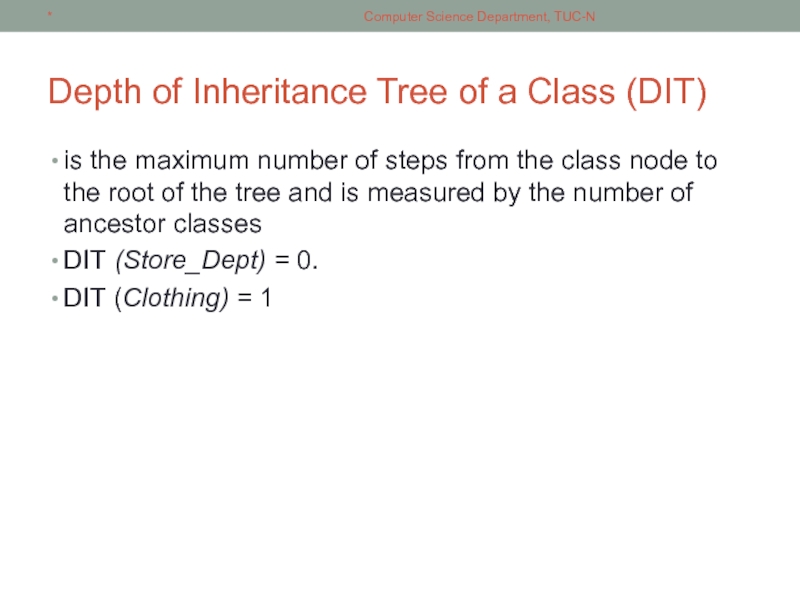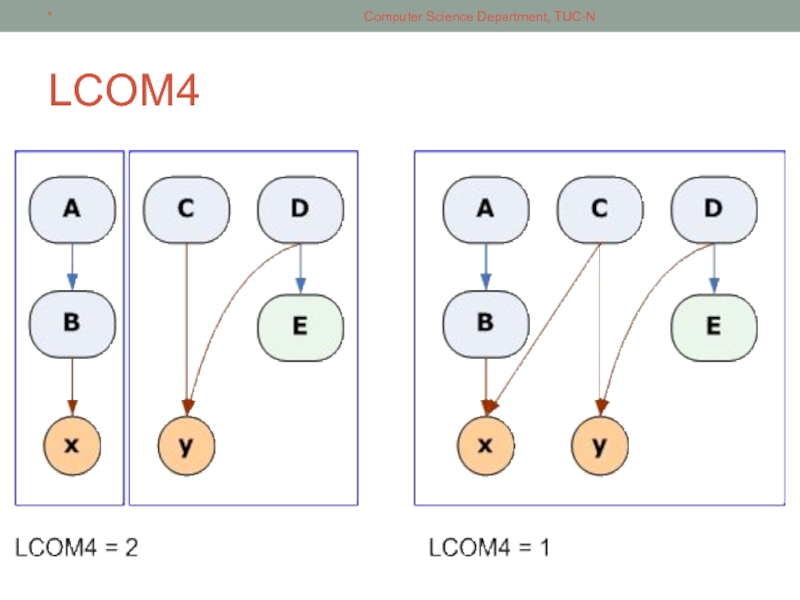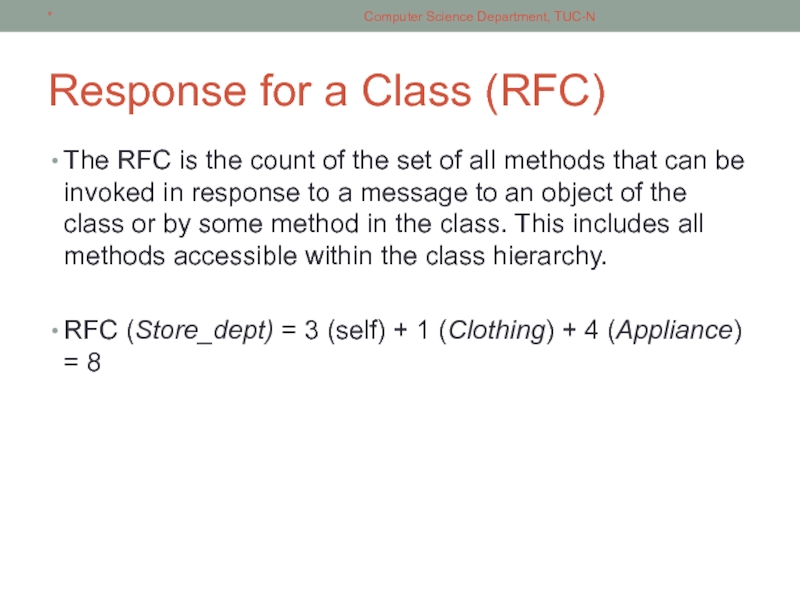- Главная
- Разное
- Дизайн
- Бизнес и предпринимательство
- Аналитика
- Образование
- Развлечения
- Красота и здоровье
- Финансы
- Государство
- Путешествия
- Спорт
- Недвижимость
- Армия
- Графика
- Культурология
- Еда и кулинария
- Лингвистика
- Английский язык
- Астрономия
- Алгебра
- Биология
- География
- Детские презентации
- Информатика
- История
- Литература
- Маркетинг
- Математика
- Медицина
- Менеджмент
- Музыка
- МХК
- Немецкий язык
- ОБЖ
- Обществознание
- Окружающий мир
- Педагогика
- Русский язык
- Технология
- Физика
- Философия
- Химия
- Шаблоны, картинки для презентаций
- Экология
- Экономика
- Юриспруденция
Software design. (Lecture10) презентация
Содержание
- 1. Software design. (Lecture10)
- 2. Content Package Design Cohesion Principles Coupling
- 3. References David Patterson, Armando Fox, Engineering Long-Lasting
- 4. High-level Design Dealing with large-scale systems >
- 5. Issues of High-Level Design Goal partition the
- 6. Principles of OO High-Level Design Cohesion Principles
- 7. What is really Reusability ? Does copy-paste
- 8. Reuse/Release Equivalency Principle (REP) The granule
- 9. What does this mean? Reused code =
- 10. The Common Reuse Principle All classes in
- 11. What does this mean? Criteria for grouping
- 12. Common Closure Principle (CCP) The classes in
- 13. What does this mean? Another criteria of
- 14. Reuse vs. Maintenance REP and CRP makes
- 15. Acyclic Dependencies Principles (ADP) The dependency structure
- 16. Dependency Graphs * Computer Science Department, TUC-N
- 17. Breaking the Cycle Add a new package * Computer Science Department, TUC-N
- 18. Breaking the Cycle DIP + ISP * Computer Science Department, TUC-N
- 19. Stability Stability is related to the amount
- 20. Stability metrics Ca – Afferent coupling (incoming
- 21. Stable Dependency Principle (SDP) Depend in the
- 22. Where to Put High-Level Design? High-level architecture
- 23. Stable Abstractions Principle (SAP) Stable packages should
- 24. Abstractness metrics Nc = number of classes
- 25. The Main Sequence I should increase as A decreases * Computer Science Department, TUC-N
- 26. The Main Sequence Zone of Pain highly
- 27. Why measure? "When you can measure what
- 28. Why measure? Understand issues of software development
- 29. What is Measurement measurement is the process
- 30. Methodological issues Measure only for a clearly
- 31. Examples of Entities and Attributes Software Design
- 32. Types of Metric direct measurement eg. number
- 33. Types of metric nominal eg no ordering,
- 34. Types of metric interval eg. between certain
- 35. Types of metric product metrics size metrics
- 36. Product metric Example 1 - size Number
- 37. Pros and cons Pros as a cost
- 38. Product metric Example 2 - size Function
- 39. Pros and cons Pros as a cost
- 40. Product metric Example - complexity Graph Theoretic
- 41. Product metric Example - complexity V(G) =
- 42. Cyclomatic complexity (CC) CC = Number of
- 43. OO metrics Weighted Methods Per Class (WMC)
- 44. Weighted Methods Per Class (WMC) Sum of
- 45. Example WMC for Clothing =
- 46. Depth of Inheritance Tree of a Class
- 47. Number of children (NOC) Number of immediate
- 48. Coupling between objects (CBO) Number of other
- 49. Lack of cohesion (LCOM) LCOM measures the
- 50. LCOM4 LCOM4 measures the number of "connected
- 51. LCOM4 * Computer Science Department, TUC-N
- 52. Response for a Class (RFC) The RFC
- 53. Summary * Computer Science Department, TUC-N
Слайд 1SOFTWARE DESIGN
Package design principles, Software metrics
*
Computer Science Department, TUC-N
Слайд 2Content
Package Design
Cohesion Principles
Coupling Principles
Software metrics
*
Computer Science Department, TUC-N
Слайд 3References
David Patterson, Armando Fox, Engineering Long-Lasting Software: An Agile Approach Using
Taylor, R., Medvidovic, N., Dashofy, E., Software Architecture: Foundations, Theory, and Practice, 2010, Wiley [Taylor]
Gillibrand, David, Liu, Kecheng. Quality Metric for Object-Oriented Design. Journal of Object-Oriented Programming. Jan 1998.
Li, Wei. Another Metric Suite for Object–Oriented programming. Journal of Systems and Software. vol. 44, Feb. 1998
ETHZ course materials
Univ. of Aarhus Course Materials
Univ. of Utrecht Course Materials
*
Computer Science Department, TUC-N
Слайд 4High-level Design
Dealing with large-scale systems
> 50 KLOC
team of developers, rather
Classes are a valuable but not sufficient mechanism
too fine-grained for organizing a large scale design
need mechanism that impose a higher level of order
Packages
a logical grouping of declarations that can be imported in other programs
containers for a group of classes (UML)
reason at a higher-level of abstraction
*
Computer Science Department, TUC-N
Слайд 5Issues of High-Level Design
Goal
partition the classes in an application according to
Issues
What are the best partitioning criteria?
What principles govern the design of packages?
creation and dependencies between packages
Design packages first? Or classes first?
i.e. top-down vs. bottom-up approach
Approach
Define principles that govern package design
the creation and interrelationship and use of packages
*
Computer Science Department, TUC-N
Слайд 6Principles of OO High-Level Design
Cohesion Principles
Reuse/Release Equivalency Principle (REP)
Common Reuse
Common Closure Principle (CCP)
Coupling Principles
Acyclic Dependencies Principle (ADP)
Stable Dependencies Principle (SDP)
Stable Abstractions Principle (SAP)
*
Computer Science Department, TUC-N
Слайд 7What is really Reusability ?
Does copy-paste mean reusability?
Disadvantage: You own that
you must change it, fix bugs.
eventually the code diverges
Maintenance is a nightmare
Martin’s Definition:
I reuse code if, and only if, I never need to look at the source-code
treat reused code like a product ⇒ don’t have to maintain it
Clients (re-users) may decide on an appropriate time to use a newer version of a component release
*
Computer Science Department, TUC-N
Слайд 8Reuse/Release Equivalency Principle (REP)
The granule of reuse is the granule of
Either all the classes in a package are reusable or none of it is! [R. Martin]
*
Computer Science Department, TUC-N
Слайд 9What does this mean?
Reused code = product
Released, named and maintained by
Programmer = client
Doesn’t have to maintain reused code
Doesn’t have to name reused code
May choose to use an older release
*
Computer Science Department, TUC-N
Слайд 10The Common Reuse Principle
All classes in a package [library] should be
If I depend on a package, I want to depend on every class in that package! [R.Martin]
*
Computer Science Department, TUC-N
Слайд 11What does this mean?
Criteria for grouping classes in a package:
Classes that
Packages have physical representations (shared libraries, DLLs, assembly)
Changing just one class in the package -> rerelease the package -> revalidate the application that uses the package.
*
Computer Science Department, TUC-N
Слайд 12Common Closure Principle (CCP)
The classes in a package should be closed
A change that affects a package affects all the classes in that package
[R. Martin]
*
Computer Science Department, TUC-N
Слайд 13What does this mean?
Another criteria of grouping classes:
Maintainability!
Classes that tend to
Classes highly dependent
Related to OCP
How?
*
Computer Science Department, TUC-N
Слайд 14Reuse vs. Maintenance
REP and CRP makes life easier for reuser
packages very
CCP makes life easier for maintainer
large packages
Packages are not fixed in stone
early in project focus on CCP
later when architecture stabilizes: focus on REP and CRP
*
Computer Science Department, TUC-N
Слайд 15Acyclic Dependencies Principles (ADP)
The dependency structure for released component must be
[R. Martin]
*
Computer Science Department, TUC-N
Слайд 19Stability
Stability is related to the amount of work in order to
Stability = Responsibility + Independence
*
Computer Science Department, TUC-N
Слайд 20Stability metrics
Ca – Afferent coupling (incoming dependencies)
How responsible am I?
Ce –
How dependant am I?
I = Ce/(Ca+Ce) Instability
Example for X:
Ca = 3, Ce = 0 => I = 0 (very stable)
*
Computer Science Department, TUC-N
Слайд 21Stable Dependency Principle (SDP)
Depend in the direction of stability.
What does this
Depend upon packages whose I is lower than yours.
Counter-example
*
Computer Science Department, TUC-N
Слайд 22Where to Put High-Level Design?
High-level architecture and design decisions don't change
shouldn't be volatile ⇒ place them in stable packages
design becomes hard to change ⇒ inflexible design
How can a totally stable package (I = 0) be flexible enough to withstand change?
improve it without modifying it...
Answer: The Open-Closed Principle
classes that can be extended without modifying them ⇒ Abstract Classes
*
Computer Science Department, TUC-N
Слайд 23Stable Abstractions Principle (SAP)
Stable packages should be abstract packages.
What does this
Stable packages should be on the bottom of the design (depended upon)
Flexible packages should be on top of the design (dependent)
OCP => Stable packages should be highly abstract
*
Computer Science Department, TUC-N
Слайд 24Abstractness metrics
Nc = number of classes in the package
Na = number
A = Na/Nc (Abstractness)
Example:
Na = 0 => A = 0
What about hybrid classes?
*
Computer Science Department, TUC-N
Слайд 26The Main Sequence
Zone of Pain
highly stable and concrete ⇒ rigid
famous examples:
database-schemas (volatile and highly depended-upon)
concrete utility libraries (instable but non-volatile)
Zone of Uselessness
instable and abstract ⇒ useless
no one depends on those classes
Main Sequence
maximizes the distance between the zones we want to avoid
depicts the balance between abstractness and stability.
*
Computer Science Department, TUC-N
Слайд 27Why measure?
"When you can measure what you are speaking about and
Lord Kelvin (Physicist)
"You cannot control what you cannot measure."
Tom DeMarco (Software Engineer)
*
Computer Science Department, TUC-N
Слайд 28Why measure?
Understand issues of software development
Make decisions on basis of facts
Predict conditions of future developments
*
Computer Science Department, TUC-N
Слайд 29What is Measurement
measurement is the process by which numbers or symbols
*
Computer Science Department, TUC-N
Слайд 30Methodological issues
Measure only for a clearly stated purpose
Specifically: software measures should
Assess the validity of measures through controlled, credible experiments
Apply software measures to software, not people
Goal-Question-Metric Approach
*
Computer Science Department, TUC-N
Слайд 31Examples of Entities and Attributes
Software Design
Defects discovered in design reviews
Software
Number of pages
Software Code
Number of lines of code, number of operations
Software Development Team
Team size, average team experience
*
Computer Science Department, TUC-N
Слайд 32Types of Metric
direct measurement
eg. number of lines of code
indirect/ derived measurement
eg.
prediction
eg. predict effort required to develop software from measure of the functionality - function point count
*
Computer Science Department, TUC-N
Слайд 33Types of metric
nominal
eg no ordering, simply attachment of labels
(language: 3GL, 4GL)
ordinal
eg
*
Computer Science Department, TUC-N
Слайд 34Types of metric
interval
eg. between certain values (programmer capability: between 55th and
ratio
eg. the proposed software is twice as big as the software that has just been completed
absolute
eg. the software is 350,000 lines of code long
*
Computer Science Department, TUC-N
Слайд 35Types of metric
product metrics
size metrics
complexity metrics
quality metrics
process metrics
resource metrics
project metrics
*
Computer Science
Слайд 36Product metric Example 1 - size
Number of Lines of Code (NLOC)
number
number of thousands of delivered source instructions (KDSI)
Definition (Conte 1986)
"A line of code is any line of program text that is not a comment or a blank line, regardless of the number of statements or fragments of statements on the line. This specifically includes all lines containing program headers, declarations, and executable and non-executable statements."
*
Computer Science Department, TUC-N
Слайд 37Pros and cons
Pros as a cost estimate parameter:
Appeals to programmers
Fairly easy
Correlates well with other effort measures
Cons:
Ambiguous (several instructions per line,…)
Does not distinguish between programming languages of various abstraction levels
Low-level, implementation-oriented
Difficult to estimate in advance
*
Computer Science Department, TUC-N
Слайд 38Product metric Example 2 - size
Function Point Count
A measure of the
inputs to the software application
outputs from the software application
enquiries to the software application
data files
internal to the software application
shared with other software applications
*
Computer Science Department, TUC-N
Слайд 39Pros and cons
Pros as a cost estimate parameter:
Relates to functionality, not
Experience of many years, ISO standard
Can be estimated from design
Correlates well with other effort measures
Cons:
Oriented towards business data processing
Fixed weights
*
Computer Science Department, TUC-N
Слайд 40Product metric Example - complexity
Graph Theoretic Metric
The McCabe Complexity Metric
a software
each node correspond to a block of sequential code
each edge corresponds to a path created by a decision
*
Computer Science Department, TUC-N
Слайд 41Product metric Example - complexity
V(G) = e - n + 2p
e
n = number of nodes in the graph
p = number of connected module components in the graph
*
Computer Science Department, TUC-N
Слайд 42Cyclomatic complexity (CC)
CC = Number of decisions + 1
Variants:
CC2 Cyclomatic complexity
CC2 = CC + Boolean operators
CC3 Cyclomatic complexity without Cases ("modified cyclomatic complexity")
CC3 = CC where each Select block counts as one
*
Computer Science Department, TUC-N
Слайд 43OO metrics
Weighted Methods Per Class (WMC)
Depth of Inheritance Tree of a
Number of Children (NOC)
Coupling Between Objects (CBO)
Response for a Class (RFC)
Lack of Cohesion (LCOM)
*
Computer Science Department, TUC-N
Слайд 44Weighted Methods Per Class (WMC)
Sum of the complexity of each method
Method complexity: (e.g. cyclomatic complexity)
When method complexity assumed to be 1, WMC = number of methods in class
*
Computer Science Department, TUC-N
Слайд 46Depth of Inheritance Tree of a Class (DIT)
is the maximum number
DIT (Store_Dept) = 0.
DIT (Clothing) = 1
*
Computer Science Department, TUC-N
Слайд 47Number of children (NOC)
Number of immediate subclasses of a class.
NOC(Store_Dept) =
NOC(Clothing) = 0
*
Computer Science Department, TUC-N
Слайд 48Coupling between objects (CBO)
Number of other classes to which a class
Two classes are coupled when methods declared in one class use methods or instance variables defined by the other class.
The uses relationship can go either way: both uses and used-by relationships are taken into account, but only once.
Слайд 49Lack of cohesion (LCOM)
LCOM measures the dissimilarity of methods in a
Several variants
LCOM4 recommended
Слайд 50LCOM4
LCOM4 measures the number of "connected components" in a class.
A
Which methods are related? Methods a and b are related if:
they both access the same class-level variable, or
a calls b, or b calls a.
*
Computer Science Department, TUC-N
Слайд 52Response for a Class (RFC)
The RFC is the count of the
RFC (Store_dept) = 3 (self) + 1 (Clothing) + 4 (Appliance) = 8
*
Computer Science Department, TUC-N



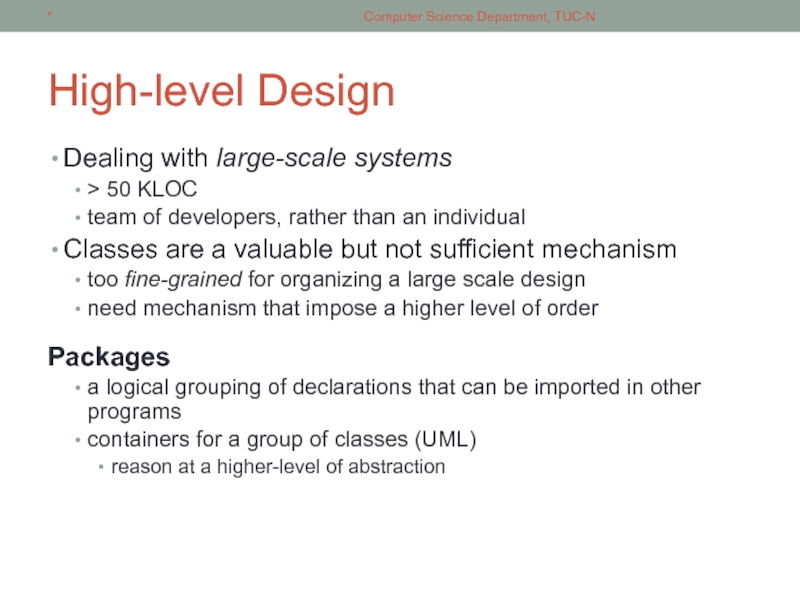


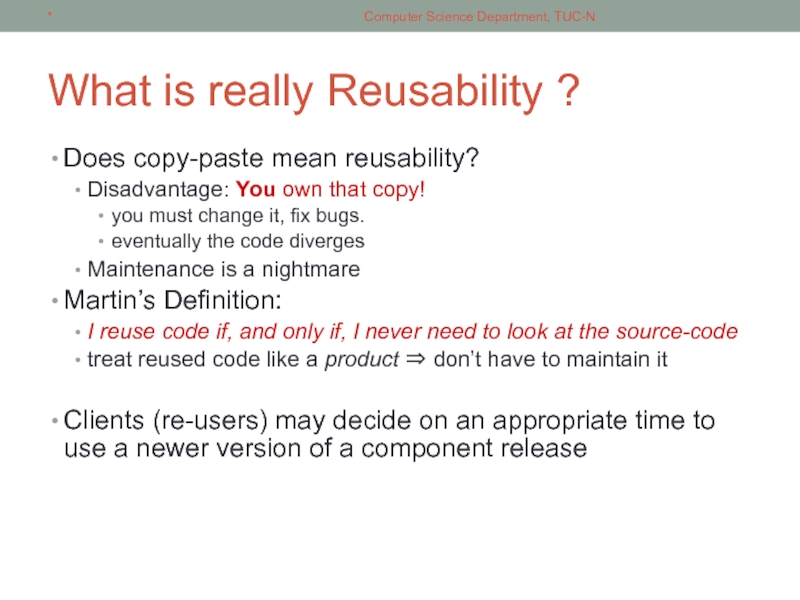


![The Common Reuse PrincipleAll classes in a package [library] should be reused together. If you](/img/tmb/4/338668/af115cad3e5a3164012fff60737dc45d-800x.jpg)






